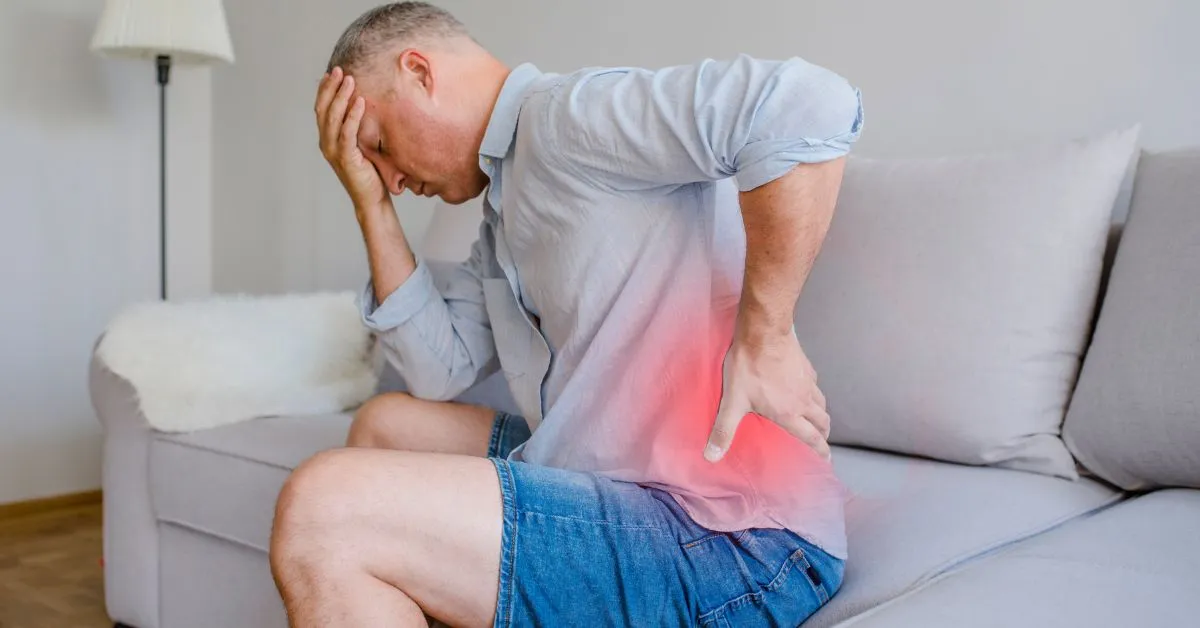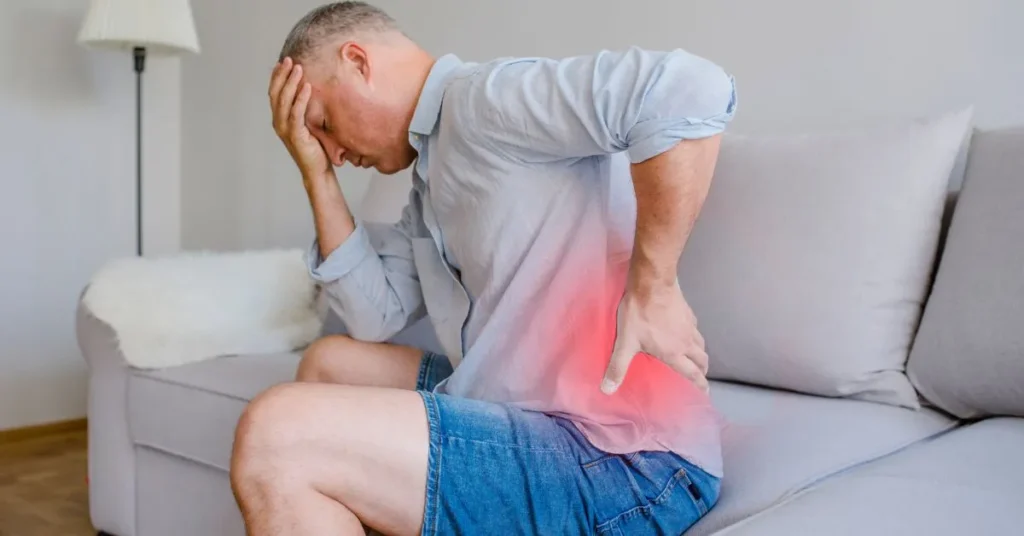
What is flank pain
Pain in different areas of the back can be debilitating and irritating. It can often impair movement and everyday activities. It can be caused by overuse in athletes, by sedentary lifestyle in the general population, and underlying conditions which need to be addressed at the doctor’s office to try and find the cause of lingering or severe pain which has been troubling you.
One of the least researched types of back pain is flank pain. However, research has shown that everyone will experience some flank pain during their lifetime. (Source: Cleveland Clinic) So, what is flank pain exactly?
Flank pain is situated in the flanks, the area between your ribs and pelvis, and it can be caused by muscle injury, kidney problems, spinal health issues, pancreas or liver problems, and more. It can be temporary discomfort or severe, persistent pain in the left or right flank, but rarely in both simultaneously.
To go any further in our research on flank pain, let’s first answer the question “what is flank pain” and move on to possible causes and treatment options so that once you have read this article, you know what the trouble has been and what action to take to get rid of this type of pain.
What IS FLANK PAIN
Flank pain is pain or discomfort in your flanks (the sides of the body between the ribs and the hip). Kidney stones, infection, and muscle strains are common causes of flank pain. Depending on the type of pain and the condition, treatment can include rest, antibiotics, and pain medication. The intensity of pain can vary and is usually located on one side of the body, sometimes changing the position to another.
The pain in the flanks can be assigned to various medical conditions, ranging from mild muscle strain by overuse or lack of movement (in people who live a sedentary lifestyle) to severe, life-threatening illnesses, such as dehydration or a urinary tract infection.
Most people experience flank pain sometimes during their lifetime. When experienced on its own and temporarily, flank pain is usually harmless. However, if it lasts longer and is severe or followed by other symptoms, you should take flank pain seriously.
Sometimes, flank pain can be followed by a fever, chills, blood in the urine, or frequent or urgent urination. In this case, a kidney problem is a likely cause.
The fact that flanks are located around various vital organs (such as kidneys, bladder, liver, and pancreas) can confuse physicians when diagnosing the cause of flank pain. These vital organs are complex, and a myriad of different medical conditions can plague each. This complexity is why sometimes the doctor will have to put you through many diagnosing procedures or laboratory tests to establish an accurate diagnosis.
To solve the problem of flank pain, let’s see first what causes it. Although it is difficult to pinpoint the exact cause of flank pain and professional assistance should be sought, we will focus on what causes flank pain in the next chapter.
what causes flank pain?
As we pointed out, the most common and the most harmless cause of flank pain are muscle problems. Although flank pain is situated on the sides of the abdomen, the pain can be caused by overuse or strain of the stomach, back, and chest muscles. Apart from strains and overuse, the pain can be triggered by tension, a sedentary lifestyle, and stress. Since muscle pain intensity is not necessarily a measure of the severity of the injury, you should contact your healthcare practitioner as soon as you have experienced flank pain for longer than two days.
One of the more severe causes of flank pain is a urinary tract infection. This type of infection is caused by harmful bacteria entering the urinary tract, infecting the bladder, urethra, or kidneys. UTIs are more common in women than in men. Suppose you have been experiencing painful urination, frequent or constant need to urinate, or blood in the urine. In that case, you should seek professional help since, without treatment, a UTI can spread to the kidneys and cause a more severe kidney infection.
Kidney problems are the following possible cause of flank pain. As we have mentioned, it can happen when a UTI has not been adequately managed, be genetic, or occur due to a problem with another organ. Kidney stones, kidney diseases, such as polycystic kidney disease, infections, a blood clot, or bleeding in the kidneys can all cause pain in the flanks.
Shingles are an infection that causes a painful, blistering rash. This infection is more common in older adults and those with a weakened immune system. Shingles are relatively easy to diagnose since the inflammation they produce is quite dramatic and easily noticeable. Those with HIV and people taking immunosuppressants should see a doctor immediately if they think they have shingles.
Pancreas or liver problems are another cause of flank pain, and the pain from those problems can radiate to the back. The liver and pancreas work together to help you digest food, so a problem with the pancreas can easily cause a problem with the liver too, and vice versa. Gallstones that prevent the normal functioning of the liver or pancreas are highly treatable, while autoimmune diseases, such as hepatitis can cause chronic problems.
Spinal issues, including arthritis or herniated discs, can also be the cause of flank pain. The pain from spinal problems typically occurs on either the right or left flank, and more rarely on both sides. Spinal health issues present in the form of a sharp, shooting pain that extends down one side and into the leg, unexplained numbness or tingling, especially in the leg or foot, chronic back pain, and difficulty moving.
There are other causes of flank pain, but if you are experiencing this type of pain, the reason is very likely some of the problems mentioned above.
The complexity of flank pain causes and symptoms can make it hard for doctors to establish a diagnosis, so let’s see how it is done and what you can expect on your journey to healing flank pain.
how is flank pain diagnosed?
A professional opinion is of vital importance when diagnosing flank pain. It would be best if you never diagnosed yourself by recognizing the symptoms or guessing. No matter how harmless you think your flank pain is, you should seek medical evaluation.
Once you are at the doctor’s, they will try to narrow down potential causes of flank pain by asking about your other symptoms and taking a complete medical history. They may also run tests to gain an exclusive insight into what your diagnosis might be.
Flank Pain Diagnostic Imaging
Diagnostic imaging for Flank Pain scans to look at the kidneys, liver, pancreas, and spine.
Diagnostic imaging is a medical imaging technique used by physicians to look inside your body (in this case – kidneys, liver, pancreas, or spine, since these are the most common “perpetrators” of flank pain) for diagnostic purposes and to determine the proper treatment. Imaging scans are a non-invasive or minimally invasive methodology to view your internal tissues and organs.
Urine analysis for flank pain
The urinalysis consists of a set of tests to detect some common diseases. Doctors may use urinalysis to screen for or help diagnose urinary tract infections, kidney disorders, liver problems, diabetes, or other metabolic disorders.
Flank Pain Physical Examination
To identify muscle problems (muscle strains or overuse) or rashes (common in shingles), your physician will be examining the symmetry of the joints, muscles, and bones and checking for swelling, redness, and ease of movement. They will palpate over the joints, noting any areas of warmth or tenderness.
Blood Tests For Flank Pain
There are many different blood tests to confirm or rule out various diseases and medical conditions. Based on your personal health history, type of pain, and other assessments carried out at the physician’s office, you will be subject to a particular set of blood tests to determine the diagnosis.
As you can see, diagnosing flank pain isn’t painful. Most of these tests include imaging and are pain-free. You might only experience mild discomfort when being palpated by the physician, and your blood tests will rely on a blood sample taken from your veins, which shouldn’t be too big of a problem unless you are scared of blood. If you are, you can tell this to your doctor and find other diagnostic options together.
If established accurately, the diagnosis is the foundation for a successful treatment program that will get you rid of the chronic or acute pain in your flanks.
So, the next step is treatment options.
what are the treatments for flank pain
The treatment options for flank pain depend on the cause and the diagnosis you get from the physician. You’ll be surprised to know that you won’t be needing treatment at all in some cases. If you suffer from small kidney stones or muscle pain from cramps and sitting too long, the doctor might advise a different lifestyle, and the flank pain will disappear over time. Flank pain due to liver disease caused by an unhealthful diet might suggest different eating habits and nutrition are needed.
For other diagnoses, treatment plans can be more complex, sometimes requiring surgical interventions or physical therapy.
Urinary tract infections, kidney infections, and pancreatitis might require antibiotics. Kidney stones can be cured by dissolution. You will need to take a medicine that will make your urine less acidic because this aids the stone to dissolve.
Shingles treatment consists of administering antiviral drugs. Since emotional stress is considered a trigger for shingles, you should avoid stress and excitement. However, if you have gone through a traumatic experience or a shock, the physician might advise subsequent psychotherapy to prevent further psychosomatic problems.
Physical therapy, stretching, and rest are recommended for spinal health recuperation.
Surgical interventions are common in flank pain resulting from disc diseases, liver and kidney diseases where transplantation must be made. Since these surgeries are complex, expect six months or more recovery time before you’ll feel fully healed after your transplant surgery.
The passage above may have sounded daunting, but don’t lose your spirit! Luckily, some innovative, non-invasive ways have been discovered to treat pain without causing pain and lengthy downtimes. Our Pain Treatment in The Villages, FL is one of those treatment options. It has shown great promise in treating pain after complicated surgeries and, in some cases avoiding surgical interventions altogether.
You are wondering what Shockwave is and how it can help you? We have dedicated a whole chapter to answer those questions and help you decide which treatment option is your option of choice.
shockwave therapy for flank pain treatment
Shockwave Therapy, or Extracorporeal Shock Wave Therapy for flank pain is one of the most advanced, completely safe, and highly effective non-invasive treatment method for pain.
Through the application of this procedure, damaged tissues gradually recuperate and eventually heal. New, healthy tissues are formed, thus preventing new injuries and medical conditions. This non-invasive, clinic-based procedure is a breakthrough treatment option.
At the beginning of each Shockwave Therapy session, a coupling gel is applied to the specified treatment area to enhance effectiveness. Shockwave Therapy pressure waves are released through the applicator, moving over the area in a circular motion.
The beneficial effects of Shockwave Therapy are often experienced after only three treatments. Some patients report immediate pain relief after the treatment. The procedure eliminates pain and restores full mobility, thus improving your quality of life. Over 80% of patients treated report being pain-free and have significant pain reduction.
A wealthy medical experience, cutting-edge engineering, and optimal quality are integral to each Shockwave Therapy device. At Diamond Medical Clinic, we treat each patient as an individual, focusing on your needs and requests, devoting time and attention to make your treatment procedure as comfortable as it gets.

